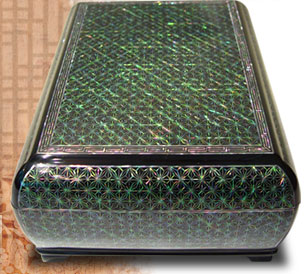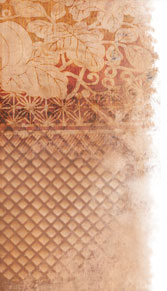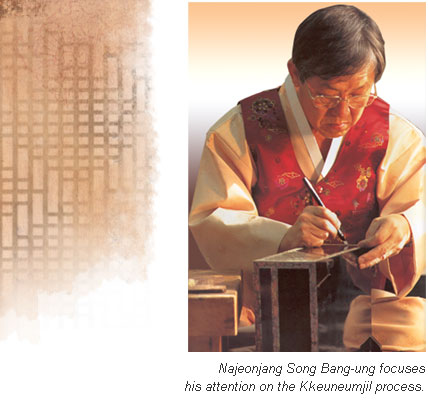 Mother of pearl, lacquer paint and wood are the three basic materials needed to make a piece of Najeon Mother of pearl, lacquer paint and wood are the three basic materials needed to make a piece of Najeon
 Chilgi, and the process involves approximately 45 time-consuming stages. The first step involves making
Chilgi, and the process involves approximately 45 time-consuming stages. The first step involves making
 a basic frame, or ‘skeleton,’ by using Red pine, Oregon pine, Zelcova, Paulownia or another fine-quality
a basic frame, or ‘skeleton,’ by using Red pine, Oregon pine, Zelcova, Paulownia or another fine-quality
 wood. When the frame is polished properly, it must be coated with saengot, or ‘fresh lacquer’ generously
wood. When the frame is polished properly, it must be coated with saengot, or ‘fresh lacquer’ generously
 and evenly. This is followed by another application of lacquer paint, or chiljuk (‘lacquer paste’) to fill up
and evenly. This is followed by another application of lacquer paint, or chiljuk (‘lacquer paste’) to fill up
 any nooks or crevices on the frame. The surface of the object is then covered with a hemp cloth, which is
any nooks or crevices on the frame. The surface of the object is then covered with a hemp cloth, which is
 lacquered on. After that, the process of drying and coating is repeated, sometimes more than 12 times,
lacquered on. After that, the process of drying and coating is repeated, sometimes more than 12 times,
 before the inlaying of the mother of pearl designs begins. The final stage involves another lengthy
before the inlaying of the mother of pearl designs begins. The final stage involves another lengthy
 process of repeated grinding, lacquering and polishing. This means that a lacquer painted
process of repeated grinding, lacquering and polishing. This means that a lacquer painted
 mother of pearl work, however tiny it may be, may take months or even years to complete.
mother of pearl work, however tiny it may be, may take months or even years to complete.
 In Korea, the technique of inlaying mother of pearl designs is largely divided into two types, In Korea, the technique of inlaying mother of pearl designs is largely divided into two types,
 Jureumjil (‘filing’) and Kkeuneumjil (‘cutting’), according to how the designs are produced and inlaid.
Jureumjil (‘filing’) and Kkeuneumjil (‘cutting’), according to how the designs are produced and inlaid.
 The first of the two methods refers to the process of marking designs such as birds and flowers
The first of the two methods refers to the process of marking designs such as birds and flowers
 onto the finished mother of pearl blanks, and removing them using scissors and files. The arrival of
onto the finished mother of pearl blanks, and removing them using scissors and files. The arrival of
 the band saw in the early 20th century made the work much easier and helped create finer designs.
the band saw in the early 20th century made the work much easier and helped create finer designs.
The second type, Kkeuneumjil, is an earlier method whose origin goes back to the Goryeo Dynasty. Here the artisan
uses a scribe with a sharp metal point to cut off thin tiny strips called sangsa (‘figure thread’). Once enough strips are
cut off from the blanks, the artisan inlays them one-by-one onto the surface of the frame to form a pattern, figure or
landscape. Koreans often compare this time-consuming, difficult process with embroidery on silk because the artisan
needs to be extremely careful and have a steady hand, besides possessing a high level of skill. The traditional method
of inlaying starts with applying fish glue onto the surface of a frame, which is then put aside for a while to dry. Once
it has dried, the artisan begins to lay the mother of pearl ‘threads’ onto the surface. The most remarkable part of this
inlaying process is that he has to literally lick the surface with his tongue while inlaying to produce the optimum temperature
and moisture for the thread and skeleton to adhere to each other. “One needs to swallow,” an old saying goes, “a mal
(approximately five gallons) of fish glue to become a proper Najeon artisan. ” This difficult yet admirable procedure
demonstrates the Korean mother of pearl artist’s dedication and love for his work, and how his sacrifices are worth it
when a perfect lacquer paint mother of pearl work reveals its glorious form.
 Najeonjang Song Bang-ung excels in the Kkeuneumjil method Najeonjang Song Bang-ung excels in the Kkeuneumjil method
 above all others and was designated as a Master Craftsman because above all others and was designated as a Master Craftsman because
 he revived and perfected the traditional technique, which dates back he revived and perfected the traditional technique, which dates back
 to the Goryeo period. He shuns using any modern materials or tools, to the Goryeo period. He shuns using any modern materials or tools,
 although he invented a new sangsa knife to help him make extremely although he invented a new sangsa knife to help him make extremely
 fine cuts and inlays. fine cuts and inlays.
 Song Bang-ung is highly regarded for the simple beauty in his designs; Song Bang-ung is highly regarded for the simple beauty in his designs;
 however, he is also praised for creating a wide variety of motifs, from however, he is also praised for creating a wide variety of motifs, from
 traditional geometric patterns to figures. He has continued to extend traditional geometric patterns to figures. He has continued to extend
 the borders of his design so that now he crafts complex landscapes the borders of his design so that now he crafts complex landscapes
 that are comparable to a real painting. that are comparable to a real painting.

 More than a thousand years ago, Najeon Chilgi of Goryeo were coveted More than a thousand years ago, Najeon Chilgi of Goryeo were coveted
 treasures in East Asia. Although the kingdom is ancient history, the glory of treasures in East Asia. Although the kingdom is ancient history, the glory of
 lacquer paint mother of pearl art remains with us thanks to the extraordinary lacquer paint mother of pearl art remains with us thanks to the extraordinary
 efforts by true artisans, such as Najeonjang Song Bang-ung, to reveal efforts by true artisans, such as Najeonjang Song Bang-ung, to reveal
 its splendor and brilliance now and in the days to come. its splendor and brilliance now and in the days to come.
|


















